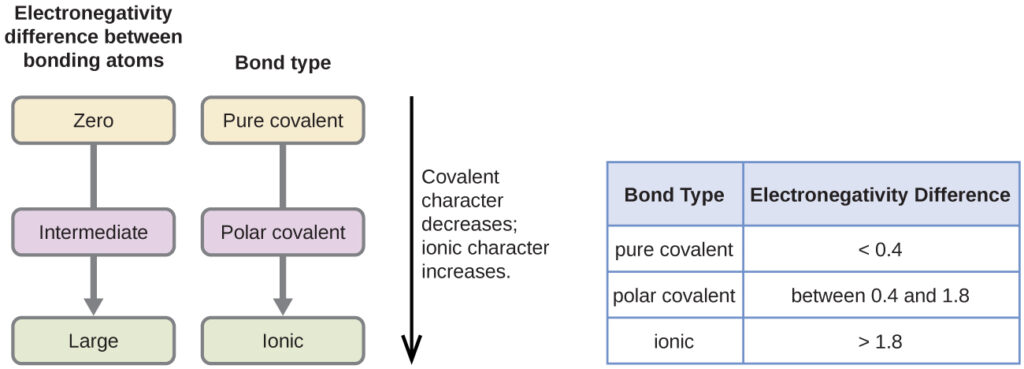The absolute value of the difference in electronegativity (ΔEN) of two bonded atoms provides a rough measure of the polarity to be expected in the bond and, thus, the bond type. When the difference is very small or zero, the bond is covalent and nonpolar. When it is large, the bond is polar covalent or ionic. There absolute values of the electronegativity differences between the atoms in the bonds are shown below:
- H–H [ΔEN = 0 (nonpolar covalent or pure covalent bonding)],
- H–Cl [ΔEN = 0.9 (polar covalent)], and
- Na–Cl [ΔEN = 2.1 (ionic bonding)].
The degree to which electrons are shared between atoms varies from completely equal (pure covalent bonding) to not at all (ionic bonding). The figure below shows the relationship between electronegativity difference and bond type.

A rough approximation of the electronegativity differences associated with covalent, polar covalent, and ionic bonds is shown in the figure above. This table is just a general guide, however, with many exceptions. For example, the H and F atoms in HF have an electronegativity difference of 1.9, and the N and H atoms in NH3 a difference of 0.9, yet both of these compounds form bonds that are considered polar covalent. Likewise, the Na and Cl atoms in NaCl have an electronegativity difference of 2.1, and the Mn and I atoms in MnI2 have a difference of 1.0, yet both of these substances form ionic compounds.
The best guide to the covalent or ionic character of a bond is to consider the types of atoms involved and their relative positions in the periodic table. Bonds between two nonmetals are generally covalent; bonding between a metal and a nonmetal is often ionic.
Some compounds contain both covalent and ionic bonds. The atoms in polyatomic ions, such as OH–, NO3−, and NH4+, are held together by polar covalent bonds. However, these polyatomic ions form ionic compounds by combining with ions of opposite charge. For example, potassium nitrate, KNO3, contains the K+ cation and the polyatomic NO3− anion. Thus, bonding in potassium nitrate is ionic, resulting from the electrostatic attraction between the ions K+ and NO3−, as well as covalent between the nitrogen and oxygen atoms in NO3−.
Electronegativity and Bond Polarity
Bond polarities play an important role in determining the structure of proteins. Using the electronegativity values in the previous page, arrange the following covalent bonds—all commonly found in amino acids—in order of increasing polarity. Then designate the positive and negative atoms using the symbols δ+ and δ–:
C–H, C–N, C–O, N–H, O–H, S–H
Solution
The polarity of these bonds increases as the absolute value of the electronegativity difference increases. The atom with the δ– designation is the more electronegative of the two. The table below shows these bonds in order of increasing polarity.
| Bond | ΔEN | Polarity |
|---|---|---|
| C–H | 0.4 | δ−C−Hδ+ |
| S–H | 0.4 | δ−S−Hδ+ |
| C–N | 0.5 | δ+C−Nδ− |
| N–H | 0.9 | δ−N−Hδ+ |
| C–O | 1.0 | δ+C−Oδ− |
| O–H | 1.4 | δ−O−Hδ+ |
Check Your LearningSilicones are polymeric compounds containing, among others, the following types of covalent bonds: Si–O, Si–C, C–H, and C–C. Using the electronegativity values in the previous page, arrange the bonds in order of increasing polarity and designate the positive and negative atoms using the symbols δ+ and δ–.
Answer:
Bond Electronegativity Difference Polarity
C–C 0.0 nonpolar
C–H 0.4 δ−C−Hδ+
Si–C 0.7 δ+Si−Cδ−
Si–O 1.7 δ+Si−Oδ−
Answer:
| Bond | Electronegativity Difference | Polarity |
|---|---|---|
| C–C | 0.0 | nonpolar |
| C–H | 0.4 | δ−C−Hδ+ |
| Si–C | 0.7 | δ+Si−Cδ− |
| Si–O | 1.7 | δ+Si−Oδ− |